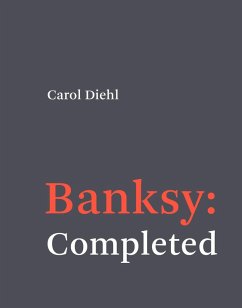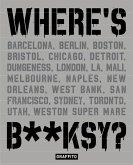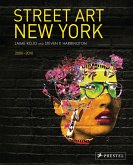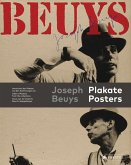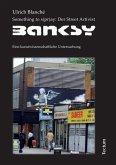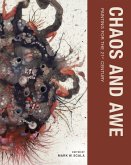There's more to Banksy than the painting on the wall: the first in-depth investigation into the mysteries of the world's most famous living artist.
Banksy is the world's most famous living artist, yet no one knows who he is. For more than twenty years, his wryly political and darkly humorous spray paintings have appeared mysteriously on urban walls around the globe, generating headlines and controversy. Art critics disdain him, but the public (and the art market) love him. With this generously illustrated book, artist and critic Carol Diehl is the first author to probe the depths of the Banksy mystery. Through her exploration of his paintings, installations, writings, and Academy Award-nominated film, Exit through the Gift Shop, Diehl proves unequivocally that there's more to Banksy than the painting on the wall.
Seeing Banksy as the ultimate provocateur, Diehl investigates the dramas that unfold after his works are discovered, with all of their social, economic, and political implications. She reveals how this trickster rattles the system, whether during his month-long 2013 self-styled New York "residency" or his notorious Dismaland of 2015, a full-scale dystopian "family theme park unsuitable for children" dedicated to the failure of capitalism. Banksy's work, Diehl shows, is a synthesis of conceptual art, social commentary, and political protest, played out not in museums but where it can have the most effect--on the street, in the real world. The questions Banksy raises about the uses of public and private property, the role of the global corporatocracy, the never-ending wars, and the gap between artworks as luxury goods and as vehicles of social expression, have never been more relevant.
Banksy is the world's most famous living artist, yet no one knows who he is. For more than twenty years, his wryly political and darkly humorous spray paintings have appeared mysteriously on urban walls around the globe, generating headlines and controversy. Art critics disdain him, but the public (and the art market) love him. With this generously illustrated book, artist and critic Carol Diehl is the first author to probe the depths of the Banksy mystery. Through her exploration of his paintings, installations, writings, and Academy Award-nominated film, Exit through the Gift Shop, Diehl proves unequivocally that there's more to Banksy than the painting on the wall.
Seeing Banksy as the ultimate provocateur, Diehl investigates the dramas that unfold after his works are discovered, with all of their social, economic, and political implications. She reveals how this trickster rattles the system, whether during his month-long 2013 self-styled New York "residency" or his notorious Dismaland of 2015, a full-scale dystopian "family theme park unsuitable for children" dedicated to the failure of capitalism. Banksy's work, Diehl shows, is a synthesis of conceptual art, social commentary, and political protest, played out not in museums but where it can have the most effect--on the street, in the real world. The questions Banksy raises about the uses of public and private property, the role of the global corporatocracy, the never-ending wars, and the gap between artworks as luxury goods and as vehicles of social expression, have never been more relevant.

Da muss sogar Marcel Duchamp herhalten: Carol Diehl lobt Banksy und wettert gegen seine Kritiker
Männliche Polizisten, die einander küssen, ein Mädchen, das mit dem Heliumballon die Mauer zwischen Israel und Palästina überwindet, Rentiere mit einem Schlitten, die auf einer Brücke den Schlafplatz eines Obdachlosen bewachen: plakativer Polit-Kitsch oder niedrigschwellige Kunst für alle? Am global agierenden Street-Art-Phantom Banksy scheiden sich die Geister. Die Kritiker des vermeintlichen "Outlaws" aus Bristol können sich für seine mit Schablonen aufgesprühten Bildern nicht erwärmen und halten seinen Ideenreichtum für überbewertet.
Auch dann, wenn Banksy etwa einen Selbstzerstörungsmechanismus in ein Werk einbaut, der sich just während seiner Versteigerung bei Sotheby's einschaltet. Originell sei das nicht, heißt es dann, der Künstler Gustav Metzger habe doch schon 1960 das "Manifest der autodestruktiven Kunst" verfasst und so eine eigene Kunstrichtung geschaffen. Und dann gab es doch auch noch Jean Tinguely, der im gleichen Jahr im Garten des New Yorker Museum of Modern Art eine Maschine mit dem Titel "Hommage to New York" aufstellte, die ohne menschliches Zutun in Flammen aufging.
Der große Unbekannte, der sich weigert, seine Identität preiszugeben, hält diese Einwände für elitäres Gatekeeping und bezieht zu allem und jedem Position, sei es der Brexit, der Kunstmarkt oder das medizinische Personal, das sich auf Intensivstationen für Covid-Patienten einsetzt. Im März erzielte ein Bild zu diesem Thema 16,8 Millionen Pfund bei einer Versteigerung im Auktionshaus Christie's. Banksy spendete die Summe an den Nationalen Gesundheitsdienst (NHS). Kam das nun seiner Glaubwürdigkeit zugute, oder stellt es erst recht den Kunstmarktgewinner heraus?
Carol Diehl, amerikanische Malerin und Kunstkritikerin, lässt keinen Zweifel daran, wie sie zu Banksy steht. Ihr Buch ist von der ersten Seite an als Verteidigungsschrift konzipiert. Gleich in der Einleitung bekundet sie, dass für sie "Banksy eines der größten Genies unserer Zeit" ist, "ein würdiger Fackelträger von Marcel Duchamp", der uns zu überdenken zwingt, was Kunst sei. Allen Kunstkritikern, die anderer Meinung sind, wirft sie eine snobistische Abwehrhaltung gegenüber Künstlern vor, die Erfolg beim großen Publikum haben. Sie selbst habe sich als Malerin bereits in den Achtzigerjahren von Street Artists wie Keith Haring oder Jean-Michel Basquiat inspirieren lassen. Da sie vom Art Institute of Chicago abgelehnt worden sei, habe sie Abendkurse besucht und sei ohne die zweifelhafte "Prägung der Kunstausbildung" erst in die Kunstszene eingestiegen, um anschließend für das renommierte Kunstmagazin Artforum zu schreiben.
Offenbar meint die Autorin also, aufgrund ihres eigenen Werdegangs einen glaubwürdigeren Zugang zu Banksys Kunstkonzept zu haben als die meisten ihrer über universitäre Abschlüsse verfügenden Kollegen. Die Auflistung von deren Einschätzungen nimmt beträchtlichen Platz ein, vom "Entertainment für Teenager" bis "eine Kunst für alle, die den Turner-Preis hassen"; die namentlich angeführten Kritiker würden eben ihre Hausaufgaben nicht machen, sobald ein Künstler nicht Teil des Systems sei und von einer Großgalerie wie Gagosian komme.
Der angriffslustige Ton durchzieht das ganze Buch. Neben der permanenten Reibung an der Ablehnung des von ihr verehrten Künstlers, garniert mit antikapitalistischen Ausfällen, schafft es Diehl aber durchaus, ein Geflecht aus Verwandtschaften und Referenzen zu spinnen, die sie am Beispiel einzelner Werke darlegt.
Sie gibt zudem Auskunft darüber, welche Bilder weiterhin am Originalschauplatz zu sehen sind, welche vernichtet oder abgenommen und verkauft wurden. Auch wenn man nicht unbedingt wissen möchte, was sie beim Besuch des satirischen Kunstprojekts "Dismaland" in England oder der Nachfolgearbeit "The Walled Off Hotel" in Bethlehem empfunden hat, sind die Einordnungen in den jeweiligen gesellschaftlichen Kontext lesenswert. Man verzeiht ihr auch manche Redundanz, wenn sie etwa immer wieder betont, wie wichtig die Auswahl der Standorte sei, der Überraschungseffekt oder Banksys Botschaften in den sozialen Medien, die um Themen wie Überwachung, Digitalisierung, Terrorismus, Klima- und Migrationskrise kreisen. Man kann Diehls Text als Update zu den Debatten um Banksy lesen. Und ertappt sich vielleicht dabei, zwischen den Positionen hin und her gerissen zu werden. ALEXANDRA WACH
Carol Diehl: "Banksy: Completed".
The MIT Press, Cambridge, Mass., 2021. 216 S., Abb., geb., 25, 99 Euro.
Alle Rechte vorbehalten. © F.A.Z. GmbH, Frankfurt am Main
"Carol Diehl s impassioned, lucid, and fascinating book Banksy: Completed was published in 2021. Anyone interested in contemporary art should read it. It made me radically reevaluate my take on the anonymous provocateur, whose 2013 one-month New York residency I had totally ignored. Like most people involved in the serious (ahem) art world, I had taken Banksy for a reasonably clever, certainly daring, but ultimately shallow performer of some kind of brand, kind of a parody of an artist. I couldn t have been more wrong."
Cocoa the Journal of Cornwall Contemporary Art
"In this first in-depth analysis of anonymous activist, filmmaker, and street artist Banksy, Diehl (scholar and art critic) offers a rich discussion of the antiauthoritarian artist. Banksy emerged in Bristol, UK, in the 1990s in the underground scene, with its public antiestablishment art that often targeted fascism, surveillance, capitalism, and consumerism. Though Banksy produced documentation of his work with publications in 2001, 2002, and 2005 and the film Exit through the Gift Shop (2010), Diehl examines Banksy's works and reminds readers that viewers, critics, scholars, and the public are essential to the work. They complete it. Diehl rightly critiques the art world's annoyance and indignation with an artist whose success has captured attention within and beyond the art world despite, or because, the art resides outside representation and the dealer-auction-market system that has prevailed over three centuries. Rather than incorporate traditional footnotes, Diehl includes citations, in order of appearance, beneath each chapter heading in the back matter. Perhaps such a construction is Diehl's own act of resistance, taking cues from Banksy's forms of critique and self-expression. Marked by rich illustrations and absorbing prose, this volume will interest those studying contemporary art, street art and graffiti, art markets, material culture, and visual culture. Recommended. Lower-division undergraduates through faculty and professionals."
CHOICE
"Looks [at] the dramas that unfold after Banksy's artworks are discovered around the world... Gorgeous, well researched."
Daily Hive
Cocoa the Journal of Cornwall Contemporary Art
"In this first in-depth analysis of anonymous activist, filmmaker, and street artist Banksy, Diehl (scholar and art critic) offers a rich discussion of the antiauthoritarian artist. Banksy emerged in Bristol, UK, in the 1990s in the underground scene, with its public antiestablishment art that often targeted fascism, surveillance, capitalism, and consumerism. Though Banksy produced documentation of his work with publications in 2001, 2002, and 2005 and the film Exit through the Gift Shop (2010), Diehl examines Banksy's works and reminds readers that viewers, critics, scholars, and the public are essential to the work. They complete it. Diehl rightly critiques the art world's annoyance and indignation with an artist whose success has captured attention within and beyond the art world despite, or because, the art resides outside representation and the dealer-auction-market system that has prevailed over three centuries. Rather than incorporate traditional footnotes, Diehl includes citations, in order of appearance, beneath each chapter heading in the back matter. Perhaps such a construction is Diehl's own act of resistance, taking cues from Banksy's forms of critique and self-expression. Marked by rich illustrations and absorbing prose, this volume will interest those studying contemporary art, street art and graffiti, art markets, material culture, and visual culture. Recommended. Lower-division undergraduates through faculty and professionals."
CHOICE
"Looks [at] the dramas that unfold after Banksy's artworks are discovered around the world... Gorgeous, well researched."
Daily Hive

